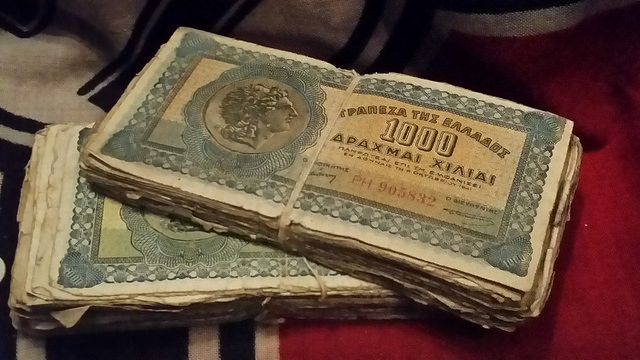
WW2 Greek Currency via Flickr
Currency devaluation does not create long term, stable, cost savings for mining companies.
Currently, most cost savings touted by mining companies are driven by a weakening of local currency vs USD. However, I don’t think this can be counted on in the long term. At best, it is a nine-month lag, and afterwards, the local costs are going to go back up, which will impact earnings for everyone from Rio Tinto to Fortescue.
I was in Yellowknife two times last month, with roughly 12 days of spacing between the stays (it was a stop on my way to and from Aston Bay’s Storm Copper Project). I am someone who eats food from supermarkets when I travel, which allows me to get a sense of the local economy via the price of food in the stores.
Even over only 12 days, there was a noticeable change in prices of some of the items in the local stores. Most starkely, prices increased on imported goods at a much higher rate than they did on local goods. When the price to import chocolate goes up 30%, at some point the consumer is going to have to pay for that increase.
When looking at this from a mining exploration perspective, here are some items that are internationally priced.
- Fuel: All energy that is not captive.
- Food: Most of it, though some of it more than others.
- Vices: Beer, single malts and other libations, including tobacco and pot.
- Labor: If the cost of food, fuel and beer increases, so does the cost of labor.
- Debt: Capital is internationally priced. If Canada has a higher interest rate vs the US, the capital will flow (and visa versa).
- Equipment: Tires, fluids, explosives, and other consumables.
For the short term, you can take 100% of the currency savings and be happy, but realize that it will get degraded with time, and at the end, it is doubtful that more than 30% of the change is going to be stable (and that 30% assumes that the currency stays low).
Previously, I have seen that local prices are quickly adjusted due to currency devaluation in the immediate panic, but it seems to take two times as long for the prices to come back down locally when the currency valuation goes the other way. People price for 70 cents CDN to USD in a hurry, but when they go back to parity, Canadian suppliers take their sweet time to come back in the other direction.
So, if you think long-term currency gains are going to stay around, I have a bridge from London to sell you.
Comment to Benjamin Cox via CEO.CA Chat





















